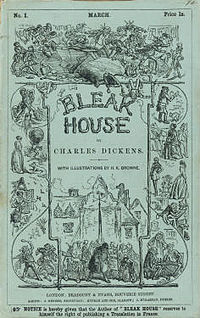Bleak House is Dickens' ninth novel, published in 1853. It has dozens of plots and subplots, but the main story revolves around the long-running court case "Jarndyce and Jarndyce", and the lives affected and destroyed by it.
Dickens used a very unusual form of narration for this story. Instead of being narrated entirely in the first person by one of the characters, like David Copperfield, or entirely in the third person by an omniscient narrator, like Our Mutual Friend, Bleak House has two narrators. One is Esther Summerson, whose part of the story is most directly associated with Jarndyce and Jarndyce. The other is an unnamed narrator who describes the mystery surrounding Lady Dedlock. This book is the only time Dickens used this sort of storytelling.
The main characters of Esther's story are Esther herself, Ada Clare, Richard Carstone, and John Jarndyce. The main characters of the other narrator's story are Lord and Lady Dedlock, Mr. Tulkinghorn, and Inspector Bucket. Several of these characters never meet in person, but their actions affect other people's lives. Running through the entire story are the mysteries of Esther's parents and Lady Dedlock's secret.
Dickens' forte was satire, and there's plenty of it in Bleak House. Jarndyce and Jarndyce, and the case of poor Mr. Gridley, is a satire of the real-life long-running cases (one of which lasted 117 years!) and the flaws in the Chancery court system. Tom-All-Alone's and Nemo's grave are based on real places that poor people lived, died and were buried in. The ridiculous figures of Mrs. Jellyby and Mrs. Pardiggle are caricatures of the "philanthropists" who care nothing for the suffering all around them.
Bleak House, as its name suggests, is extremely bleak in some parts. Jo's death and the descriptions of poverty in Victorian London are among the most depressing scenes. But it has some comical moments, too. Mr. Guppy's proposals are absolutely hilarious.
The characters range from the morally outstanding, like John Jarndyce, Esther, and Dr. Woodcourt, to the vile and despicable, like Mr. Tulkinghorn, Mr. Smallweed, and Hortense. Then there's the eccentric but kindly Miss Flyte, the apparently cold and indifferent Lady Dedlock, the vain and insufferable Mr. Turveydrop, the loathsome Mr. Skimpole, and a host of others both good and bad.
Because of its length and complicated plot, there are fewer adaptations of Bleak House than there are of, say, A Tale of Two Cities. But the best is undoubtedly the 2005 series. It doesn't adapt every sentence of the book (something that would be very difficult to do, and would probably be a bore to watch), but it sticks very close to the plot.
Great as the adaptation is, though, it still can't compare to the brilliance that is the original novel. Bleak House wouldn't be the best introduction to Dickens (his shorter works would be better for that), but if you're already familiar with his writing style then you'll be able to understand and enjoy it as it deserves.
Is it available online?: Yes, on Gutenberg.
Rating: 10/10.
Dickens' forte was satire, and there's plenty of it in Bleak House. Jarndyce and Jarndyce, and the case of poor Mr. Gridley, is a satire of the real-life long-running cases (one of which lasted 117 years!) and the flaws in the Chancery court system. Tom-All-Alone's and Nemo's grave are based on real places that poor people lived, died and were buried in. The ridiculous figures of Mrs. Jellyby and Mrs. Pardiggle are caricatures of the "philanthropists" who care nothing for the suffering all around them.
Bleak House, as its name suggests, is extremely bleak in some parts. Jo's death and the descriptions of poverty in Victorian London are among the most depressing scenes. But it has some comical moments, too. Mr. Guppy's proposals are absolutely hilarious.
The characters range from the morally outstanding, like John Jarndyce, Esther, and Dr. Woodcourt, to the vile and despicable, like Mr. Tulkinghorn, Mr. Smallweed, and Hortense. Then there's the eccentric but kindly Miss Flyte, the apparently cold and indifferent Lady Dedlock, the vain and insufferable Mr. Turveydrop, the loathsome Mr. Skimpole, and a host of others both good and bad.
Because of its length and complicated plot, there are fewer adaptations of Bleak House than there are of, say, A Tale of Two Cities. But the best is undoubtedly the 2005 series. It doesn't adapt every sentence of the book (something that would be very difficult to do, and would probably be a bore to watch), but it sticks very close to the plot.
Great as the adaptation is, though, it still can't compare to the brilliance that is the original novel. Bleak House wouldn't be the best introduction to Dickens (his shorter works would be better for that), but if you're already familiar with his writing style then you'll be able to understand and enjoy it as it deserves.
Is it available online?: Yes, on Gutenberg.
Rating: 10/10.

No comments:
Post a Comment